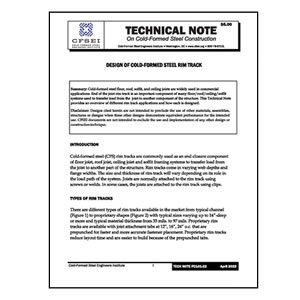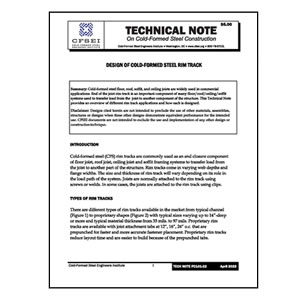Tech Note FC101-22: Design of Cold-Formed Steel Rim Track
$5.00
Summary: Cold-formed steel floor, roof, soffit, and ceiling joists are widely used in commercial applications. End of the joist rim track is an important component of many floor/roof/ceiling/soffit systems used to transfer load from the joist to another component of the structure. This Technical Note provides an overview of different rim track applications and how each is designed.
Disclaimer: Designs cited herein are not intended to preclude the use of other materials, assemblies, structures or designs when these other designs demonstrate equivalent performance for the intended use. CFSEI documents are not intended to exclude the use and implementation of any other design or construction technique.
Related Products

Tech Note F101-12: Screws for Cold-Formed Steel-To-Wood and Wood-To-Cold-Formed Steel Attachments
Summary: Screws are often used to attach cold-formed steel (CFS) framing to wood members or wood structural panel decking to CFS joists or rafters. The AISI North American Specification for the Design of Cold-Formed Steel Structural Members (AISI S100) provides design equations for screw connection capacity for CFS members. The National Design Specification for Wood Construction (NDS) provides design equations for fastener/connection capacity (nails, wood screws, bolts, etc.) in wood members. The Engineered Wood Association (APA) and the building codes offer several resources for determining the capacity of screw connections attaching wood sheathing. This Tech Note reviews these resources and discusses design and detailing of these fastener connections.
Disclaimer: Designs cited herein are not intended to preclude the use of other materials, assemblies, structures or designs when these other designs demonstrate equivalent performance for the intended use. CFSEI documents are not intended to exclude the use and implementation of any other design or construction technique.

Tech Note W102-21: Introduction to Curtain Wall Design using Cold-Formed Steel
Summary: A curtain wall can be defined as a non-vertically loaded exterior wall (aside for self-weight) support by the primary structural frame of the building. When it comes to cold-formed steel framing, this definition can encompass a great many possible assemblies and applications. This Technical Note discusses the various structural elements of a curtain wall system, and introduces the subjects of design loads and framing analysis.
This Technical Note updates and replaces CFSEI Tech Note W102-12
Disclaimer: Designs cited herein are not intended to preclude the use of other materials, assemblies, structures or designs when these other designs demonstrate equivalent performance for the intended use. CFSEI documents are not intended to exclude the use and implementation of any other design or construction technique.

Tech Note B010-21: Introduction to AISI S202, Code of Standard Practice for Cold-Formed Steel Structural Framing
Summary: Understanding the responsibilities of the different parties involved in a cold-formed steel framing project can be confusing. This Technical Note is an introduction to AISI S202, Code of Standard Practice for Cold-Formed Steel Structural Framing published by the American Iron and Steel Institute (AISI).
Disclaimer: Designs cited herein are not intended to preclude the use of other materials, assemblies, structures or designs when these other designs demonstrate equivalent performance for the intended use. CFSEI documents are not intended to exclude the use and implementation of any other design or construction technique.

Tech Note B008-20: Basic C-Shaped Wall Stud Behavior
Summary: Although cold-formed steel framing shares some limit states with hot-rolled steel, cold-formed steel framing and specifically C-Shaped studs exhibit unique behaviors when subjected to various loading conditions. This Tech Note gives an overview of those unique behaviors that need to be considered when designing C-Shaped cold-formed steel members.
Disclaimer: Designs cited herein are not intended to preclude the use of other materials, assemblies, structures or designs when these other designs demonstrate equivalent performance for the intended use. CFSEI documents are not intended to exclude the use and implementation of any other design or construction technique.

Tech Note G105-22: Compression Member Reinforcement
Summary: To modify the capacity of a compression member, e.g. wall stud or truss web, adding a reinforcement may result in a non-prismatic member. This Tech Note provides guidance to evaluate the strength of a non-prismatic compression member.
Disclaimer: Designs cited herein are not intended to preclude the use of other materials, assemblies, structures or designs when these other designs demonstrate equivalent performance for the intended use. CFSEI documents are not intended to exclude the use and implementation of any other design or construction technique.

Tech Note B009-20: Structural Versus Nonstructural Cold-Formed Steel Framing
Summary: This Tech Note defines structural and non-structural cold-formed steel framing. It lists code definitions that can be used to categorize framing in question.
Disclaimer: Designs cited herein are not intended to preclude the use of other materials, assemblies, structures or designs when these other designs demonstrate equivalent performance for the intended use. CFSEI documents are not intended to exclude the use and implementation of any other design or construction technique.

Tech Note S200-20: Design of Cold-Formed Steel Systems for Raised Platforms, Stages and Theater Seating
Summary: It is common for cold-formed steel (CFS) to be used in the construction of raised platforms, stages, and theater seating. It is the intent of the Technical Note to provide an overview of considerations to address when designing such framing, along with some design examples.
Disclaimer: Designs cited herein are not intended to preclude the use of other materials, assemblies, structures or designs when these other designs demonstrate equivalent performance for the intended use. CFSEI documents are not intended to exclude the use and implementation of any other design or construction technique.

Tech Note B003-20: Introduction to Building Codes
Summary: The International Code Council develops a suite of building codes that are considered nationally to be the model codes for the building industry. Local jurisdictions adopt, and in some cases amend, the codes and they become the law of the jurisdiction for building design and construction. The adopted building codes are intended to provide minimum requirements to provide a safe building environment. Among other requirements, the code dictates the maximum allowable size of a building based on its intended use, materials used in construction, fire resistance rating of structural elements, and the presence of automatic sprinkler systems. The International Building Code establishes all design loads to be applied to the building or structure. The building code also relies on references to other standards and specifications to ensure the provisions reflect the current industry practice. For cold-formed steel framing, the IBC references the American Iron and Steel Institute’s suite of framing standards as the accepted design methods and procedures.
Disclaimer: Designs cited herein are not intended to preclude the use of other materials, assemblies, structures or designs when these other designs demonstrate equivalent performance for the intended use. CFSEI documents are not intended to exclude the use and implementation of any other design or construction technique.

